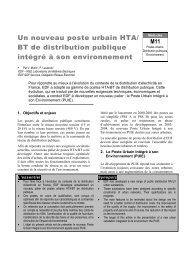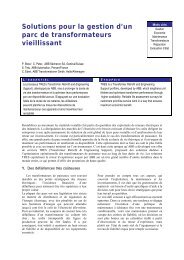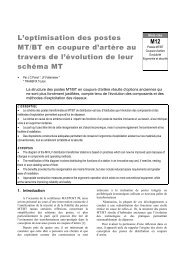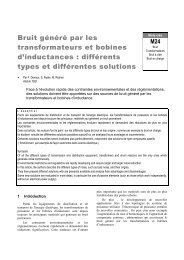Article - matpost 2003
Article - matpost 2003
Article - matpost 2003
You also want an ePaper? Increase the reach of your titles
YUMPU automatically turns print PDFs into web optimized ePapers that Google loves.
3.4 Bushings<br />
3.4.1 Detection of overvoltages<br />
The voltage applied to the transformer is acquired at<br />
the measuring tap of the capacitor bushing by means of<br />
a voltage sensor. It acts with the capacity of the bushing<br />
as a voltage divider. This enables not only the<br />
measurement of the operational voltage but also the<br />
detection of overvoltages, because due to its design the<br />
voltage sensor has a bandwidth up to some MHz. The<br />
output of the voltage sensor is connected to a peak<br />
sampler to detect the amplitude of overvoltages by the<br />
monitoring system. Overvoltages represent an essential<br />
risk potential for the insulation of transformer windings.<br />
Taking into account the volume of noxious gases which<br />
are dissolved in oil deductions can be drawn about the<br />
possible damage to the insulation of the active part after<br />
the occurrence of overvoltages.<br />
3.4.2 Change of capacitance<br />
Failure of condenser bushings occurs often because<br />
of partial flashover of the metallic foils which are used<br />
for controlling the electrical field within the bushing.<br />
Such partial flashovers do not lead to a sudden failure of<br />
the bushing, but they are growing from layer to layer<br />
until the voltage stress of the remaining layers is so high<br />
that complete breakdown occurs. If a partial flashover<br />
of one layer occurs, the capacitance of the bushing will<br />
be increased according to table 1 by ∆C.<br />
Voltage [kV] Number of foils ∆C<br />
123 28 3.6 %<br />
245 42 2.4 %<br />
400 60 1.7 %<br />
550 70 1.4 %<br />
Tab. 1: ∆C for partial flashover of one layer for oilimpregnated<br />
bushings [9]<br />
The change of the capacitance ∆C of the bushings<br />
can be detected by the monitoring system by comparing<br />
the output of one voltage sensor with the average value<br />
of the other two phases. The result is processed by<br />
averaging algorithms to eliminate imbalances of the grid<br />
voltage and variations due to temperature changes. This<br />
is assumed to be possible, because the deterioration<br />
process normally has a considerable longer time<br />
constant. This triggers an alarm and a warning<br />
In Fig. 4 the change of capacitance of a 400 kV grid<br />
coupling transformer is shown for a time interval of two<br />
month. It can be seen that variations due to unbalanced<br />
voltages and temperature variations is in the range of<br />
0.4 %. The signal to noise ratio is therefore sufficient to<br />
assess the insulation condition reliably. At a warning<br />
level of 1 % the monitoring system triggers a message<br />
for inspection of the bushing.<br />
Fig: 4:<br />
Voltage and change of capacitance of 400 kV<br />
bushings<br />
3.5 On-load Tap Changer<br />
An important component of a power transformer<br />
and also a frequent reason for severe failures is the onload<br />
tap changer [13]. Therefore the monitoring of this<br />
highly stressed element is a necessity.<br />
3.5.1 Tap changer position<br />
Recordings of the tap changer position and the<br />
operating current help to determine the number of tap<br />
switching operations and the total switched current.<br />
As the contact wear of the diverter switch contacts is a<br />
function of the switched load current this information is<br />
needed for performing a condition based maintenance<br />
for the diverter switch [14]. If an excessive wear<br />
situation is undetected, the contacts may burn open or<br />
weld together. To avoid these problems limiting values<br />
for the time in service, number of operations and total<br />
switched load current, can be pre-set in accordance with<br />
the maintenance instructions of the OLTC<br />
manufacturer.<br />
3.5.2 Assessment of mechanical condition<br />
OLTC failures are often dominated by mechanical<br />
faults in nature. Such defects can be for example broken<br />
linkage, failure of springs, binding of contacts, worn<br />
gears and problems with the drive mechanism [15].<br />
Mechanical and control problems can be detected by<br />
measurement of the power consumption of the OLTC<br />
drive, because additional friction, extended changer<br />
operation times and other abnormalities have a<br />
significant influence on the drive current. An event<br />
record of the power consumption is captured during<br />
each tap changing process and analysed by evaluation of<br />
6 characteristic parameters which are:<br />
1. Time of inrush current:<br />
The inrush current flows during a period of about<br />
300 ms. It is related to the static friction and backlash in<br />
the linkages.<br />
2. Total switching time:<br />
Variation of time required for a tap changing<br />
process indicates problems with the control of the<br />
OLTC.










